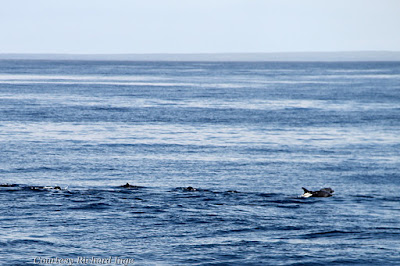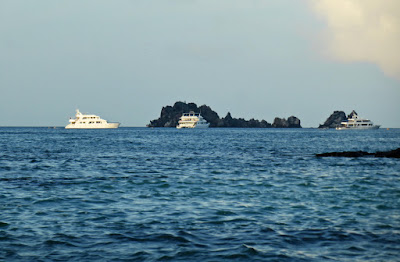As we sailed towards our afternoon destination, the island of Santa Fé, an announcement came that dolphins had been spotted. Our friend Rick had been skeptical that our ship would ever change course for wildlife, and possibly upset a schedule, despite our assurances that Lindblad did indeed do that, and often. The ironclad Lindblad rule is to never get so close, or come up so fast, that the animals' natural behavior is disturbed.
I didn't catch any worthwhile photos, but Rick did. Thank him for these views of dolphins, sea lions, and sea birds all attacking a school of fish.
Here we're following the dolphins at a respectful distance.
Rick took these pictures before the hunting grew too frenzied with the arrival of sea lions.
Here we have a dolphin, two sea lions, and a frigate bird hovering over the action.
Towards the end the birds dominated the scene, with diving boobies, pelicans, and kleptoparasitic frigates.
At Santa Fé our first activity was snorkeling in a protected cove. I still wore the flotation vest, but this time I took the waterproof camera along. I wore a standard facemask, although I'm somewhat nearsighted and presbyopic, because I wasn't going to invest in a corrective mask before I'd ever snorkeled. This led to sometimes putting the camera controls in the wrong position, but there were still interesting shots taken.
Here's a picture with a partially inflated flotation vest. The amount of air the snorkeler blows into the vest determines the degree of buoyancy.
The vest makes it effortless to float, and to stick your head up and look around. However, it will prevent diving.
I discovered at the pool where I took an introductory snorkeling lesson that going down more than about 10 feet started to hurt my ears, so diving wasn't a big temptation except in shallow waters.
The snorkelers needed to stay together to allow the monitoring zodiacs to keep an eye on everyone. Part of my attention was dedicated to not bumping or kicking someone, or being bumped.
I also needed to stick close to my snorkeling buddy, Joan. But one of my closest encounters, early in the swim, was with a pair of sea lions. My camera was on the wrong setting, but this out-of-focus image will give you the idea.
This sea lion had a hook in his mouth with a foot or two of trailing line. Joan alerted the naturalist in the zodiac, but the only action available to Lindblad was to alert the park rangers.
There were colorful little fishies,
and the best picture of the day, when Joan spotted this stone scorpionfish, which lurks in camouflage for something edible to pass by. Do not touch -- the spines are poisonous.
There were fleets of king angelfish.
And sergeant majors.
These are probably rainbow wrasse.
These unlikely creatures are cornet fish.
Here a yellowtail surgeonfish is passing in front of a white-tipped reef shark. This shark species is not interested in humans, and is a common sight while snorkeling in shallow water.
By the end one of my toes was being rubbed by the fin, and my calves were complaining. I was relieved for the swim to be over, unlike the first two snorkels which were over too soon.
After snorkeling we took a short hike on Santa Fé as the sun drooped lower. This island had been overrun by goats and donkeys installed by humans, but these have been successfully eradicated.
There were land iguanas from the get-go.
Many of the travelers stopped for a pose at this majestic cactus-tree, including Joan and me.
Nearby one cactus pad hosted a peephole.
Another posing iguana.
The iguana's favorite food, the cactus blossom.
An iguana with a beer belly. Cactus belly? A cargo of eggs?
In any case, it approached us.
A closeup. The right is my good side.
Rick took this photo of the iguana approaching Joan's boot. It nonchalantly kept going, and then waddled off into the rocks.
Yes, the wildlife was unconcerned. This sea lion was napping across the trail.
It had the right-of-way, so we detoured around it.
Rick spotted a sea lion mother and pup nursing, hidden by rocks.
Our walk ended back at the beach, facing the cove in which we'd snorkeled.
A ray moved through the shallow edge of the waters.
A sea lion pup was trying to decide where to go next.
And then we saw why these creatures weren't out in the cove. The naturalists explained that this was the fin of a galapagos shark, a species that often reaches 3 meters (~10 ft.) in length.
It can be aggressive, and had it appeared while we were snorkeling, we would have been recalled immediately!
Then it was time to return to the Islander after another successful day.
Showing posts with label sea lion. Show all posts
Showing posts with label sea lion. Show all posts
Wednesday, September 21, 2016
Monday, August 29, 2016
Galapagos: Floreana (Part 2 of 2)
After the first two activities of the day, and before lunch, it was time to go snorkeling for the second time on this trip. Both the advanced and the beginner groups would swim just off Champion Islet, the advanced snorkelers on the more active side in terms of current, and the beginners on the calmer side. However, unlike the first snorkeling trip for beginners, there would be no beach; we would slip into the water from the zodiac and never set foot on a solid surface. This was enough of a step-up in challenge for me that I decided to again use the snorkeling flotation vest, and leave the underwater camera behind. (I will have underwater photos, just later in the trip.)
Lynn Fowler, the expedition leader, accompanied our beginner group. I enjoyed it and felt a sense of accomplishment, although this was the first time I'd swum in a group. I needed to stick close to Joan, my snorkeling buddy, without bumping into anybody else. One highlight was when Joan spotted a chocolate-chip sea star.
After lunch Lynn gave an absorbing presentation on her graduate study work in the Galapagos. To quote from the Lindblad web site:
It's a wet landing at the post office beach.
Here's the post office. It was established by whalers in 1793; seafarers would deposit letters in the barrel and pick up the ones they could carry onward.
Vanessa explained the history and operation of the post office.
Then all the letters and cards were brought out of the barrel, and the destinations read out by our three naturalists, Vanessa, Christian,
and Jeffo, whose picture hasn't appeared in this blog until now.
There were one or two Ohio-bound pieces, but none close enough for Joan and me to consider hand delivering.
After returning to the Islander there were two activity choices: kayaking and zodiac cruising. Joan and I opted for the zodiacs, but saw some of the kayak operations. Here the kayakers are being helped into their vessels from the embarkation zodiac. (Click on the image to enlarge.)
The kayakers' zodiac kept an eye on things after all the kayaks set out.
This zodiac cruise was the best so far. Early on we approached a beach full of resting sea lions.
The sand must make a great back-scratcher.
Some sea lions were enjoying the surf.
At least one was determined to investigate us.
Sally Lightfoot crabs, and oystercatchers.
Lynn Fowler, the expedition leader, accompanied our beginner group. I enjoyed it and felt a sense of accomplishment, although this was the first time I'd swum in a group. I needed to stick close to Joan, my snorkeling buddy, without bumping into anybody else. One highlight was when Joan spotted a chocolate-chip sea star.
After lunch Lynn gave an absorbing presentation on her graduate study work in the Galapagos. To quote from the Lindblad web site:
Lynn completed a doctorate (also at the University of Florida) in 1983, based on her research of the giant tortoises of Alcedo Volcano on Isabela Island, where she spent a year and a half living on the rim of the crater collecting data.Then the Islander began to sail around Floreana to the site of the first "post office" in the Galapagos. In this photo, taken from the stern, Champion is on the left and Floreana on the right.
It's a wet landing at the post office beach.
Here's the post office. It was established by whalers in 1793; seafarers would deposit letters in the barrel and pick up the ones they could carry onward.
Vanessa explained the history and operation of the post office.
Then all the letters and cards were brought out of the barrel, and the destinations read out by our three naturalists, Vanessa, Christian,
and Jeffo, whose picture hasn't appeared in this blog until now.
There were one or two Ohio-bound pieces, but none close enough for Joan and me to consider hand delivering.
After returning to the Islander there were two activity choices: kayaking and zodiac cruising. Joan and I opted for the zodiacs, but saw some of the kayak operations. Here the kayakers are being helped into their vessels from the embarkation zodiac. (Click on the image to enlarge.)
The kayakers' zodiac kept an eye on things after all the kayaks set out.
This zodiac cruise was the best so far. Early on we approached a beach full of resting sea lions.
The sand must make a great back-scratcher.
Some sea lions were enjoying the surf.
At least one was determined to investigate us.
Sally Lightfoot crabs, and oystercatchers.
Here's a brown pelican.
I love this picture of the snoozing sea lion and the sally lightfoot.
This great blue heron didn't want to pose for me, but instead sat stealthily in the mangrove, where these birds nest.
Two kayakers passed in front of a large mangrove thicket. These salt-tolerant plants have extensive underwater root systems that provide invaluable shelter for young fish and turtles. The extensive nutrients in the brackish water (sea water diluted by freshwater seepage) also encourage bird nesting. The endemic and endangered Galapagos penguins of Isabela island depend on mangroves.
This clump shows that the tide is in.
Kayaks as well as zodiacs must take the channels between rocky islets.
Other tour boats are at anchor here, but we seem to own this patch. The Islander does have the 2pm-6pm slot.
A visit from another Islander zodiac.
Rick shares our zodiac, and he's having a great time too.
Sunset comes quickly at the equator -- the sun doesn't approach the horizon at an angle, but drops straight down.
It's time for everybody to return to the Islander and the evening program.
Not to mention dinner!
I love this picture of the snoozing sea lion and the sally lightfoot.
This great blue heron didn't want to pose for me, but instead sat stealthily in the mangrove, where these birds nest.
Two kayakers passed in front of a large mangrove thicket. These salt-tolerant plants have extensive underwater root systems that provide invaluable shelter for young fish and turtles. The extensive nutrients in the brackish water (sea water diluted by freshwater seepage) also encourage bird nesting. The endemic and endangered Galapagos penguins of Isabela island depend on mangroves.
This clump shows that the tide is in.
Kayaks as well as zodiacs must take the channels between rocky islets.
Other tour boats are at anchor here, but we seem to own this patch. The Islander does have the 2pm-6pm slot.
A visit from another Islander zodiac.
Rick shares our zodiac, and he's having a great time too.
Sunset comes quickly at the equator -- the sun doesn't approach the horizon at an angle, but drops straight down.
It's time for everybody to return to the Islander and the evening program.
Not to mention dinner!
Subscribe to:
Comments (Atom)
























































